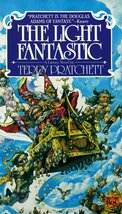
| Series: | Discworld #2 |
| Publisher: | Signet |
| Copyright: | 1986 |
| Printing: | March 1988 |
| ISBN: | 0-451-16241-2 |
| Format: | Mass market |
| Pages: | 255 |
The Light Fantastic is the second Discworld book, the second that follows Rincewind and Twoflower, and a direct sequel to the cliffhanger at the end of The Colour of Magic. Pratchett does reintroduce all the characters and the basics of their situation, but I recommend reading the previous book first.
This is the first full novel-length Discworld story and it picks up, both stylistically and plotwise, where The Colour of Magic leaves off. Rincewind and Twoflower are rescued from their situation, rather mysteriously, and are immediately dumped into another set of random encounters and wanders across Discworld. They run into another parody of sword and sorcery stories, this time a rather elderly hero, and continue moving from peril to peril through most of the book. The catch this time is that the Great A'Tuin is bringing Discworld closer to a malevolent red star and the end of the world may be at hand.
A novel-length story gives Pratchett a chance to develop some ideas at greater length. We find out quite a bit more about the spell stuck in Rincewind's head, the book it came from, the other seven spells, and the opinions of other wizards on the whole thing. The second (and often more interesting) thread of The Light Fantastic follows the wizards of the Unseen University, their problems with the Octavo, and an internal power struggle against a particularly grey parody of the worst of ambitious bureaucracy.
Pratchett here moves away from more obvious parody and further develops the style that will characterize the rest of the series. There are considerably more footnotes, expanding on surrealistic absurdity in the wonderful faux-scholarly way that Pratchett has. I also noticed more puns and more successful ones. Cohen is still more generic sword and sorcery parody than I'd prefer, a bit boring by the end of the book, but he's more successful than the more generic barbarian of the previous book.
The star of this book, though, is the Luggage. In The Colour of Magic, it was mostly a force of nature. In The Light Fantastic, it develops a personality, shows more emotions and reactions than just indomitable loyalty, and is an active participant in the plot. Rincewind and Twoflower aren't bad characters, but the best part of reading their story is to see what the Luggage will do next. Pratchett has a gift for magical items with a mind of their own, seen also in the magical books and spells in this story, and the Luggage's cross between loyal dog and mischievous D&D-style chest mimic is brilliant.
The problems for this book came at the end, when it felt like the story ran out of steam. There's a lot of running away from red star cultists and messing about with the spell in Rincewind's head as the characters are slowly lined up for the predictable showdown in the Unseen University. After all of the build-up, the resolution of the red star story was a bit anti-climactic. It's not bad, but I didn't think the end was as funny as the rest of the story.
Rincewind and Twoflower are, apart from the Luggage, not the strength of Pratchett's Discworld series, and the next book leaves them behind to tell a completely different story. They're skippable in favor of starting at Mort, Guards, Guards, or Equal Rites. But even if it's not as brilliant as some of the other books in the series, The Light Fantastic is fun and worth reading just for the Luggage.
For all of the Discworld books, there are excellent annotations on-line at the L-Space Web. I highly recommend them (although read the books first, or at least simultaneously). They add a lot of depth, particularly for the early books that aren't as interesting on their own.
Followed by Equal Rites in the chronological sense and (later) by Sourcery in the plot sense.
Reviewed: 2007-12-30